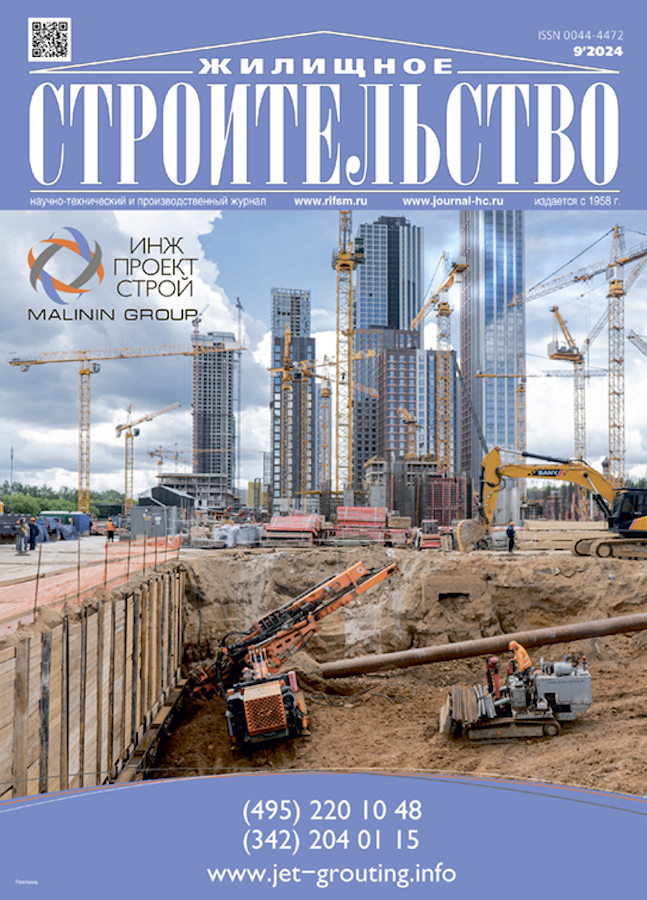Перспективы использования изделий из пеностекла в основании зданий и сооружений на многолетнемерзлых грунтах
- Авторы: Ильичев В.А.1, Никифорова Н.С.2, Коннов А.В.3
-
Учреждения:
- Российская академия архитектуры и строительных наук
- Национальный исследовательский Московский государственный строительный университет
- Научно-исследовательский институт строительной физики РААСН
- Выпуск: № 9 (2024)
- Страницы: 36-41
- Раздел: СТАТЬИ
- URL: https://ter-arkhiv.ru/0044-4472/article/view/642652
- DOI: https://doi.org/10.31659/0044-4472-2024-9-36-41
- ID: 642652
Цитировать
Аннотация
Деградация вечной мерзлоты является причиной нарастания деформативности оснований зданий и сооружений, построенных на многолетнемерзлых грунтах. Необходима разработка геотехнических решений, гарантирующих обеспечение их эксплуатационной надежности в условиях потепления климата. Актуальным является внедрение пеностекла для использования в криолитозоне в качестве теплоизоляционных решений, позволяющих сохранить мерзлое состояние грунтов оснований. Это позволит ограничить применение материалов, имеющих меньшую долговечность. Рассмотрена существующая сфера применения пеностекла в России и перспективы использования изделий из пеностекла в зоне многолетней мерзлоты. Высокую перспективность использования пеностекла в основании зданий и сооружений на многолетнемерзлых грунтах определяют его физико-механические и теплофизические характеристики, такие как долговечность, низкое водопоглощение и экологическая безопасность. Эти свойства пеностекла делают его перспективным материалом для использования в зоне многолетней мерзлоты. Основными преимуществами пеностекла по сравнению с его аналогами также являются низкая сорбционная способность и капиллярная всасываемость, высокая прочность, огнестойкость и устойчивость против агрессивных сред. При производстве пеностекла для применения в криолитозоне возможно использование альтернативных местных источников сырья – алюмосиликатных и кремнистых пород. Это снизит стоимость материала, сделает его более доступным и увеличит объемы реализации.
Полный текст
Об авторах
В. А. Ильичев
Российская академия архитектуры и строительных наук
Email: n.s.nikiforova@mail.ru
д-р техн. наук, академик РААСН, профессор
Россия, 127025, г. Москва, ул. Новый Арбат, 19Н. С. Никифорова
Национальный исследовательский Московский государственный строительный университет
Автор, ответственный за переписку.
Email: n.s.nikiforova@mail.ru
д-р техн. наук
Россия, 129337, г. Москва, Ярославское ш., 26А. В. Коннов
Научно-исследовательский институт строительной физики РААСН
Email: n.s.nikiforova@mail.ru
канд. техн. наук
Россия, 127238, г. Москва, Локомотивный пр., 21Список литературы
- Nikiforova N.S., Konnov A.V. Forecast of the soil deformations and decrease of the bearing capacity of pile foundations operating in the cryolithozone // International Journal for Computational Civil and Structural Engineering. 2022. № 18 (1), pp. 141–150.
- Бессонов И.В., Коротков Е.А., Говряков И.С., Горбунова Э.А., Тайчинов Д.Р. Исследование и оценка теплозащитных свойств щебня из пеностекла при использовании его в проблемных грунтах // Строительные материалы. 2024. № 6. С. 13–20. https://doi.org/10.31659/0585-430X-2024-825-6-13-20
- Бессонов И.В., Бруяко М.Г., Горбунова Э.А., Говряков И.С. Исследование модифицирующих добавок вспененного жидкого стекла // Строительные материалы. 2023. № 6. С. 16–20. https:// doi.org/10.31659/0585-430X-2023-814-6-16-20
- Никифорова Н.С., Коннов А.В. Эффективность применения пеностекла для предотвращения деградации грунтов в криолитозоне // Материалы международной научно-технической конференции «Механика грунтов в геотехнике и фундаментостроении». Новочеркасск, 28–30 сентября 2022 г. С. 61–69.
- Галкин А.Ф., Железняк М.Н., Жирков А.Ф. Повышение тепловой устойчивости дорожных одежд в криолитозоне // Строительные материалы. 2021. № 7. С. 26–31. https://doi.org/10.31659/0585-430X-2021-793-7-26-31
- Бессонов И.В., Жуков А.Д., Боброва Е.Ю. Исследования теплоизоляционных свойств щебня из пеностекла в основаниях автомобильных дорог в многолетнемерзлых и пучинистых грунтах // Транспортное строительство. 2022. № 2. С. 12–15.
- Никифорова Н.С., Коннов А.В. Несущая способность свай в многолетнемерзлых грунтах при изменении климата // Construction and Geotechnics. 2021. Т. 12. № 3. C. 14–24. https://doi.org/10.15593/2224-9826/2021.3.02
- Ильичев В.А., Никифорова Н.С., Коннов А.В. Влияние преобразования грунтов криолитозоны на их температурное состояние в основании здания // Жилищное строительство. 2022. № 9. С. 12–17. https://doi.org/10.31659/0044-4472-2022-9-12-17
- Иванов К.С. Новый изоляционный материал для термостабилизации грунтов // Криосфера Земли. 2011. Т. XV. № 4. С. 120–122.
- Бессонов И.В., Жуков А.Д., Боброва Е.Ю., Говряков И.С., Горбунова Э.А. Анализ конструктивных решений в зависимости от типа изоляционных материалов в дорожных покрытиях в многолетнемерзлых грунтах // Транспортное строительство. 2022. № 1. С. 14–17.
- Ильичев В.А. Перспективы развития поселений Севера в современных условиях. М.: Российская академия архитектуры и строительных наук, 2003. 151 с.
- Никифорова Н.С., Коннов А.В. Применение пеностекла для защиты деградирующих грунтов криолитозоны // Construction and Geotechnics. 2023. Т. 14. № 1. С. 99–110. https://doi.org/10.15593/2224-9826/2023.1.08
- Ilyichev V.A., Nikiforova N. S., Konnov A.V. Foamed polyethylene installation to prevent permafrost degradation. Smart Geotechnics for Smart Societies: Proc. of the 17th Asian Regional Conference on Soil Mechanics and Geotechnical Engineering (Astana, Kazakhstan, 14–18 August, 2023). 2023, pp. 1797–1802. https://doi.org/10.1201/9781003299127-270
- Бессонов И.В., Боброва Е.Ю., Агафонова Н.З., Говряков И.С., Горбунова Э.А. Проектные решения и моделирование температурных полей в системах теплоизоляции в основаниях автомобильных дорог в многолетнемерзлых грунтах // Транспортное строительство. 2023. № 3. С. 32–34.
- Овсянников С.Н., Околичный В.Н. Теплозащита многолетнемерзлых грунтов оснований зданий и сооружений. Материалы XIV Международной научно-практической конференции «Инвестиции, градостроительство, недвижимость как драйверы социально-экономического развития территории и повышения качества жизни населения». Томск, 12–14 марта 2024 г. С. 39–44.
- Иванов К.С., Радаев С.С., Селезнева О.И. Диатомиты в технологии гранулированного пеностекла // Стекло и керамика. 2014. № 5. С. 15–19.
- Vasileva D.V., Fedorov V.I., Mestnikov A.E. Physical and mechanical properties of granulated foam glass – Foam zeolite and light concrete based on it. AIP Conference Proceedings. 2015, 020109 (2018). https://doi.org/10.1063/1.5055182
Дополнительные файлы










